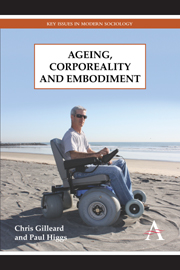Book contents
- Frontmatter
- Contents
- Introduction
- Chapter 1 Identity, Embodiment and the Somatic Turn in the Social Sciences
- Chapter 2 Corporeality, Embodiment and the ‘New Ageing’
- Chapter 3 Gender, Ageing and Embodiment
- Chapter 4 Age and the Racialised Body
- Chapter 5 Disability, Ageing and Identity
- Chapter 6 Sexuality, Ageing and Identity
- Chapter 7 Sex and Ageing
- Chapter 8 Cosmetics, Clothing and Fashionable Ageing
- Chapter 9 Fitness, Exercise and the Ageing Body
- Chapter 10 Ageing and Aspirational Medicine
- Conclusions: Ageing, Forever Embodied
- References
- Index
- ADVANCE PRAISE
Chapter 6 - Sexuality, Ageing and Identity
Published online by Cambridge University Press: 05 July 2013
- Frontmatter
- Contents
- Introduction
- Chapter 1 Identity, Embodiment and the Somatic Turn in the Social Sciences
- Chapter 2 Corporeality, Embodiment and the ‘New Ageing’
- Chapter 3 Gender, Ageing and Embodiment
- Chapter 4 Age and the Racialised Body
- Chapter 5 Disability, Ageing and Identity
- Chapter 6 Sexuality, Ageing and Identity
- Chapter 7 Sex and Ageing
- Chapter 8 Cosmetics, Clothing and Fashionable Ageing
- Chapter 9 Fitness, Exercise and the Ageing Body
- Chapter 10 Ageing and Aspirational Medicine
- Conclusions: Ageing, Forever Embodied
- References
- Index
- ADVANCE PRAISE
Summary
Earlier chapters have explored the embodied identities of gender, race and disability and how these different engagements can transform our understanding of ageing and its embodiment. The post-sixties' cultural environment, we have suggested, re-oriented social relations around the body while also facilitating the commodification, segmentation and fetishisation of the body through lifestyle marketing (Heath and Potter 2005). These developments problematised the bodily binary oppositions such as man/woman, black/white and able-bodied/disabled. With the opening up of second modernity and the ageing of those cohorts involved in its features, the binary opposition of ‘youth’ versus ‘age’ also began to unravel. Ageing, and bodily ageing in particular, was represented through a more diverse and contested set of narratives and practices which were oriented less towards realising a particular version of ‘old age’ than to not becoming old. By asserting the continuing relevance for ‘performing age’ of the various narratives associated with able-bodiedness, gender and ‘race’, alternative ways of ageing could be constructed that could not be easily reduced to the old narratives of decline (Gullette 1997).
Societal concerns surrounding sexuality and sexual orientation also provide an equally important terrain where a confrontation between the binary narratives of youth and age is witnessed. More than other forms of embodied identity, identities that privilege sexual preference and sexual practice can be seen to position themselves against the conventional embodiment of age. Youthfulness has long been associated with sexual desire; age with its decline.
- Type
- Chapter
- Information
- Ageing, Corporeality and Embodiment , pp. 87 - 100Publisher: Anthem PressPrint publication year: 2013



